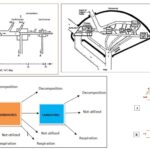Plasmodium falciparum
Pathogenesis
Transmission occurs when an infected female Anopheles mosquito injects sporozoites into the human bloodstream during a blood meal
Sporozoites invade hepatocytes and undergo exoerythrocytic schizogony, producing thousands of merozoites that are released into the circulation
Merozoites invade red blood cells and develop through ring, trophozoite, and schizont stages, culminating in erythrocyte rupture and release of new infective forms
Infected erythrocytes express PfEMP1, promoting cytoadherence to endothelial receptors and sequestration in microvasculature, leading to microvascular obstruction and local inflammation
Pro‑inflammatory cytokines such as TNFα and IL‑1 are released, driving fever, endothelial activation, and systemic inflammatory response
Pathological effects
Periodic high‑grade fevers, rigors, and chills corresponding to synchronous schizont rupture
Hemolytic anemia, jaundice, and splenomegaly due to massive destruction and clearance of parasitized erythrocytes
Cerebral malaria characterized by seizures, altered consciousness, and high mortality from brain microcirculatory obstruction
Acute kidney injury, metabolic acidosis, and hypoglycemia arising from microvascular dysfunction and high parasite biomass
Diagnosis
Thick and thin Giemsa‑stained blood smears remain the gold standard for detecting ring forms, trophozoites, schizonts, and gametocytes
Rapid diagnostic tests targeting HRP2 antigen provide point‑of‑care detection with high sensitivity for P. falciparum
PCR assays enable species‑specific identification and quantification of parasitemia in reference laboratories
Prevention
Insecticide‑treated bed nets and indoor residual spraying reduce mosquito‑human contact and transmission risk
Chemoprophylaxis with atovaquone‑proguanil, doxycycline, or mefloquine is recommended for travelers to endemic regions
RTS,S vaccine implementation in high‑burden areas has been shown to decrease clinical malaria incidence
Candida albicans
Pathogenesis
Normally a commensal yeast on mucosal surfaces, it undergoes a morphological switch to pseudohyphae and true hyphae under immunocompromised or dysbiotic conditions, facilitating tissue invasion
Adhesin proteins Als3 and invasin Ssa1 mediate tight binding to epithelial and endothelial cells, triggering endocytosis of the fungus
Secretion of hydrolytic enzymes, including secreted aspartyl proteases (SAPs) and phospholipases, degrades host tissues and promotes deep invasion
Biofilm formation on indwelling medical devices generates a protected environment resistant to antifungal therapy
Pathological effects
Oropharyngeal candidiasis presents as white adherent plaques on the tongue and buccal mucosa, often painful and bleeding on scraping
Vulvovaginal candidiasis manifests with intense itching, erythema, and thick cottage‑cheese‑like discharge
Invasive candidiasis in immunosuppressed patients can lead to candidemia, endocarditis, hepatosplenic microabscesses, and septic shock
Diagnosis
Microscopic examination of 10 % KOH wet mounts or Gram‑stained smears reveals budding yeast cells and pseudohyphae
Germ tube test in human serum at 37 °C yields true germ tubes within 2 hours, confirming C. albicans
Culture on Sabouraud dextrose agar produces creamy smooth colonies and green colonies on CHROMagar for presumptive identification
1,3‑β‑D‑glucan assay and mannan antigen detection aid in early diagnosis of invasive disease
Prevention
Maintain good mucosal hygiene and manage predisposing factors such as uncontrolled diabetes and antibiotic overuse
Employ strict aseptic technique and timely replacement of catheters and central lines to prevent device‑associated biofilm infections
Consider prophylactic fluconazole or echinocandins in high‑risk neutropenic or transplant patients
Aspergillus fumigatus
Pathogenesis
Small airborne conidia (2–3 μm) are inhaled and deposit in alveoli, where they are normally cleared by alveolar macrophages in immunocompetent hosts
In immunocompromised individuals, conidia evade phagocytosis, germinate into hyphae, and penetrate pulmonary epithelium
Hyphal angioinvasion damages vascular endothelium, induces tissue factor expression, thrombosis, and tissue infarction
Secretion of gliotoxin impairs neutrophil and macrophage function, facilitating unchecked fungal proliferation
Host airway epithelial cells release cytokines and chemokines that drive neutrophil recruitment and contribute to pulmonary inflammation
Pathological effects
Invasive pulmonary aspergillosis presents with fever, pleuritic chest pain, cough, and hemoptysis, often rapidly progressive
Allergic bronchopulmonary aspergillosis occurs in atopic individuals, leading to bronchospasm, eosinophilia, and bronchiectasis
Aspergilloma or fungus ball forms within preexisting lung cavities, causing chronic cough and hemoptysis
Chronic pulmonary aspergillosis leads to weight loss, fatigue, productive cough, and progressive respiratory failure
Diagnosis
Chest CT imaging reveals the halo sign in early invasive disease and the air crescent sign during recovery
Microscopy and culture of respiratory specimens show septate hyphae with acute angle (45°) branching
Detection of galactomannan antigen in serum or bronchoalveolar lavage fluid enables early diagnosis
Aspergillus‑specific PCR assays on blood or BAL fluid increase sensitivity, especially in neutropenic patients
Prevention
HEPA‑filtered air systems and protective isolation units reduce environmental spore exposure in high‑risk wards
Limit patient exposure to construction, gardening, and compost during periods of profound immunosuppression
Prophylactic antifungal therapy with voriconazole or posaconazole is recommended for hematopoietic stem cell transplant recipients and prolonged neutropenia
Basic Microbiology 6 Views 1 Answers
Editorial TeamLv 9April 22, 2025
Choose 1 species of protozoa and 2 species fungi/yeast/mold that you find interesting and DRAW its pathogenesis. Write its pathological effects, diagnosis and prevention
Choose 1 species of protozoa and 2 species fungi/yeast/mold that you find interesting and DRAW its pathogenesis. Write its pathological effects, diagnosis and prevention
Please login to save the post
Please login to submit an answer.
Editorial TeamLv 9May 15, 2025
0
0 likes
- Share on Facebook
- Share on Twitter
- Share on LinkedIn
0 found this helpful out of 0 votes
Helpful: 0%
Helpful: 0%
Was this page helpful?




